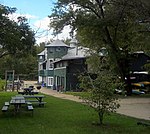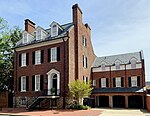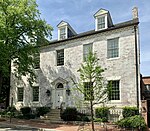Aqueduct Bridge (Potomac River)

The Aqueduct Bridge (also called the Alexandria Aqueduct) was a bridge between Georgetown, Washington, D.C., and Rosslyn, Virginia. It was built to transport cargo-carrying boats on the Chesapeake and Ohio Canal in Georgetown across the Potomac River to the Alexandria Canal. The same eight piers supported two different bridges: a wooden canal bridge (a wooden roadway bridge was added on top of the canal later) and an iron truss bridge carrying a roadway and an electric trolley line. The bridge was closed in 1923 after the construction of the nearby Key Bridge. The shuttered Aqueduct Bridge was demolished in 1933 though its arched, stone abutment on the Georgetown (north) end is still present and overseen by the National Park Service as an historic site.
Excerpt from the Wikipedia article Aqueduct Bridge (Potomac River) (License: CC BY-SA 3.0, Authors, Images).Aqueduct Bridge (Potomac River)
Capital Crescent Trail, Washington
Geographical coordinates (GPS) Address Nearby Places Show on map
Geographical coordinates (GPS)
| Latitude | Longitude |
|---|---|
| N 38.904166666667 ° | E -77.070555555556 ° |
Address
Capital Crescent Trail
Capital Crescent Trail
20057 Washington
District of Columbia, United States
Open on Google Maps









